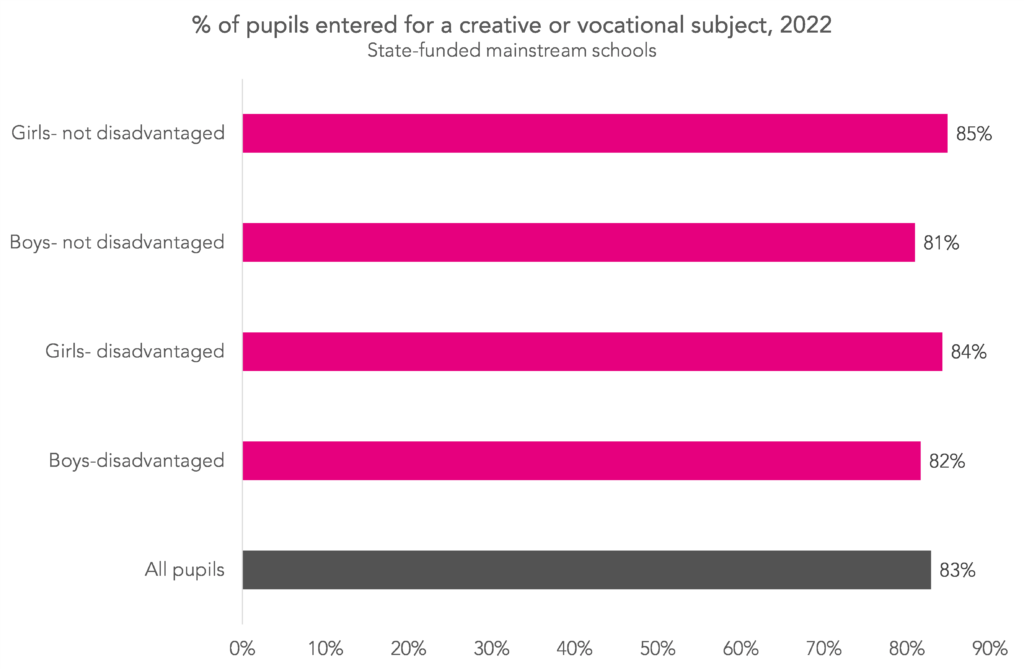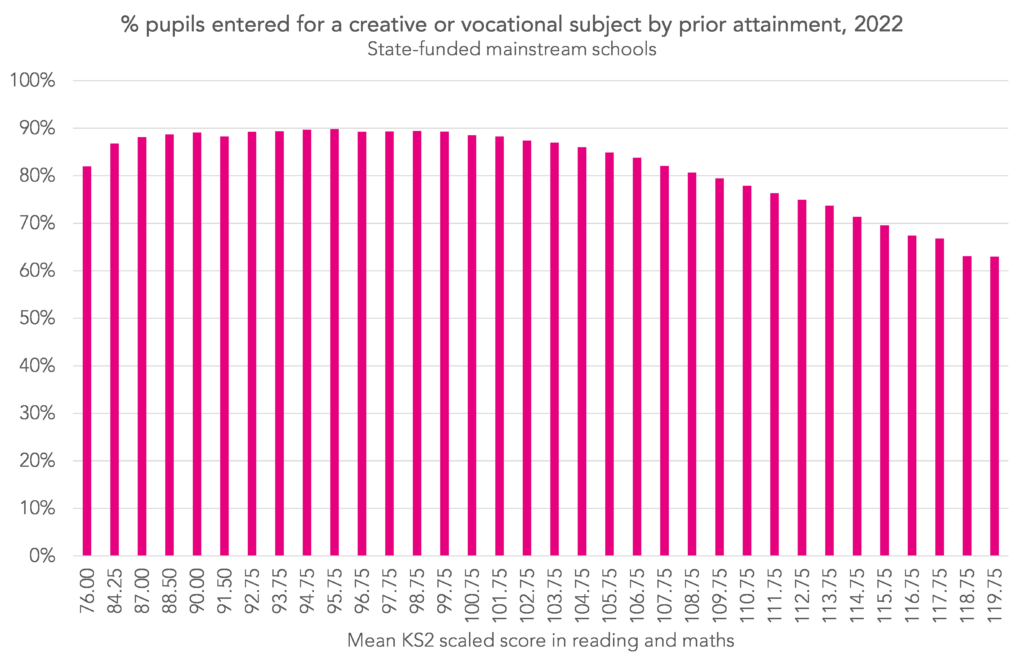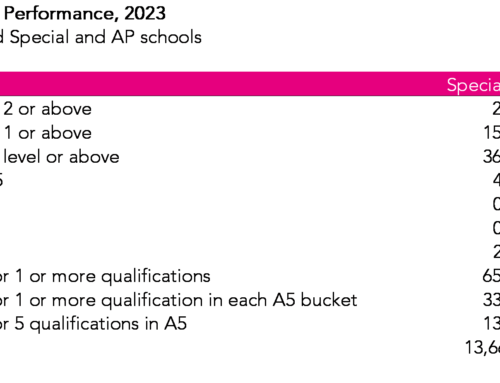In a speech delivered a few weeks ago, the leader of the opposition unveiled plans to change the key secondary school accountability metrics of Attainment 8 and Progress 8.
There would be a dedicated “slot” for creative and vocational subjects within the measure under these plans.
How might this change be implemented?
Would it make much difference to schools’ Progress 8 scores?
Well, I’ll tell you.
Creative and vocational subjects
The first thing to do is work out what we mean by creative and vocational subjects.
Creative subjects is probably easier. In a previous article we looked at take-up of qualifications in art, music, and performing and expressive arts. This found that 44% of pupils nationally in 2022 entered a GCSE or other equivalent qualification eligible for School Performance Tables in a creative subject.
I’ve adopted a fairly all-encompassing definition of creative and vocational subjects. You can see the qualifications that I have included in the annex. You’ll see that I’ve stretched the definition to include subjects such as PE and design and technology.
We find that over 80% of pupils entered a creative or vocational subject in 2022, with only relatively small differences between groups of pupils defined by disadvantage and gender.

It is pupils with the highest levels of prior attainment who were the least likely to enter a creative or vocational subject in 2022.

Before moving on, it is worth noting that there is a chance that the Labour definition will include qualifications no longer eligible for inclusion in Performance Tables but for now I leave that question to one side.
Recalculating Attainment 8
The first stage is to recalculate Attainment 8.
To recap, Attainment 8 is a score based on pupils’ grades in:
- The highest of GCSE English language or English literature (and doubled if both are entered)
- GCSE maths (doubled)
- The best 3 grades in GCSEs in the other EBacc subjects (sciences, humanities and ancient or modern foreign languages)
- The best 3 grades in subjects not counted above
Let’s say we’re going to create a “slot” in Attainment 8 based on a pupil’s best grade in creative or vocational subjects.
We have two options how to accommodate it:
- Reduce the number of “open” slots from 3 to 2, which is what Labour’s plan proposes
- Reduce the number of Ebacc slots from 3 to 2
We calculate both versions.
The table below shows the impact on Attainment 8 scores in 2022.

For pupils who entered a creative or vocational subject, there is minimal difference, particularly the approach based on reducing the number of EBacc slots.
However, for those who do not enter a creative or vocational subject, the difference is quite marked. The recalculated scores are 4 points lower on average, equivalent to not having a grade 4 pass in a GCSE counted.
Of course, if this measure were introduced there would be some warning. It would be highly likely that the proportion of pupils without an entry in a creative or vocational subject would shrink massively.
Progress 8
With recalculated Attainment 8 measures in the bag, it is now time to recalculate Progress 8.
This is a value added score. It compares a pupil’s Attainment 8 score to the national average Attainment 8 score of all other pupils with the same level of prior attainment at Key Stage 2.
A score of 0 indicates that a pupil’s Attainment 8 score was exactly in line with the average of pupils nationally with similar Key Stage 2 attainment.
Schools’ recalculated Progress 8 scores are highly correlated with their existing Progress 8 scores (r=0.99) but in a small number of cases there are differences.
Comparing the recalculated Progress 8 score in which the open slots were reduced:
- 13 schools (0.4%) would see a reduction of 0.3 points or more in their Progress 8 score
- A further 61 (1.9%) would see a reduction of 0.2 or more
- A further 259 (8.0%) would see a reduction of 0.1 or more
By way of contrast, just 11 (0.3%) schools would see their Progress 8 score increase by more than 0.1.
It should be underlined that these are relatively small changes. A score of 0.1 is equivalent to a tenth of a grade. Or, put another way, equivalent to achieving one grade higher in one of 10 GCSEs.
Multi-Academy Trusts
Finally, we look at the effect on multi-academy trust (MAT) level statistics for the 18 MATs with at least 10 schools in the 2022 Key Stage 4 data.
The Department for Education weights schools according to how long they have been in a MAT in their published statistics. We skip that here.
The table below shows that entry rates in creative and vocational subjects vary by MAT. There are one or two where 25% or more pupils were not entered for a creative subject in 2022.

Summing up
Even if it were introduced tomorrow, Labour’s plan to include creative and vocational subjects in Progress 8 would make little difference to schools’ published scores.
However, the percentage of pupils entered for a creative or vocational subject would almost certainly increase from its current level at 83%.
The risk is that schools will seek to maximize pupils’ points scores in the creative or vocational slot and this might encourage them to pursue qualifications that score more highly than others, whether they are in pupils’ best interests or not. This is a perfectly rational decision.
There have been qualifications in the past that may have been perfectly good qualifications for some pupils in some circumstances but came to be entered by much larger than anticipated numbers: GNVQ ICT, BTEC Science and ECDL immediately spring to mind. All three were entered by between 20% and 25% population of Year 11 pupils at their peak.
To avoid this, we must be honest about the points scores that we assign to qualifications.
Want to stay up-to-date with the latest research from FFT Education Datalab? Sign up to Datalab’s mailing list to get notifications about new blogposts, or to receive the team’s half-termly newsletter.







Leave A Comment